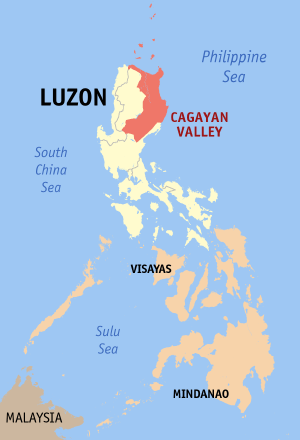ABOUT

Cagayan Valley is strategically located in the northeastern quadrant of the country. With a total land area of 26,388 square kilometers, it is the second largest region of the Philippines. The region is composed of the island group of Batanes, the valley province of Cagayan and Isabela and the generally mountainous provinces of Quirino and Nueva Vizcaya. Tuguegarao City, the regional capital, is about 485 kms. from Manila via the Maharlika Highway. It has one independent city, three component cities, 89 municipalities and 2,311 barangays within its 12 congressional districts.
Based on the 2020 Census of Population and Housing, Region 2 has a total population of 3,685,744. This accounts for about 3.38 percent of the total population of the country.
Region 2 is bounded by the Cordillera Mountain range to the west, the Sierra Madre to the east, and the Caraballo Mountain to the south. To the north lies the Babuyan Channel beyond which is the North China Sea. The mountains in the east serve as natural barriers from devastating winds during typhoon season.
The region is blessed with a wide expanse of rich agricultural lands suitable to a wide variety of agricultural commodities. It has already earned the distinction of being a major food supplier to the rest of the country, particularly in grains and legumes. Over the years, it has been the leading producer of corn and second in palay production. It is also among the major peanut and mung bean producing regions in the country.
In Region 2, there remain large tracts of land that are vacant and idle which could be tapped to produce high-value crops, livestock, and poultry or could be developed for industrial use.
It is also blessed with rich water resources. It hosts the Magat Dam, which is a source of irrigation water and hydroelectric power not only of the region but also of adjacent regions. The potential of the 500 km Cagayan River could also be tapped for blue economy.
The region is also rich in forest resources such as timber (industrial tree species), rattan, and bamboo and tiger grass. These are transformed into furniture, gifts, toys and housewares that are sold outside of the region.
Managed pastureland areas and natural grasslands cover a wide area of 550,838 hectares. This provides considerable potentials for livestock production and diversified upland farming. An additional 838,551 hectares may be cultivated for non-traditional and high-yielding crop varieties.
Beneath the vast, rich and fertile lands of the region lie metallic and non-metallic mineral reserves. Cagayan Valley has gold, silver, copper, limestone and manganese. Indigenous energy resources such as coal, natural gas, geothermal and hydroelectric capabilities have been found abundant in the Valley.
The region is also a natural catch basin having the largest watersheds in the country. It is crisscrossed by the longest and largest river network, the Cagayan River, also known as Rio Grande de Cagayan, with a total length of approximately 505 kilometers and a drainage basin covering 27,753 square kilometers.
The valley floor experiences cold winds from November to February, funneled through the opening in the north, and traps surface temperature usually from March to June. With most of the production and settlement areas along the valley floor, frequent exposure to extreme temperature is normal.
Cagayan Valley is also the most natural link between the country’s fast paced development corridors such as the Subic and Clark Freeports to its south and the large East Asian market. Being located at the northeastern quadrant of the country, its proximity to countries like Taiwan, China, Hong Kong, South Korea, and Japan can make the region as an international gateway to East Asia. This potential is further strengthened by the existence of the Cagayan Special Economic Zone and Freeport.
Bountifully endowed with vast natural resources and development potentials from its rich soil, extensive coastlines, rivers and lakes, forest, grasslands and mountain ranges, and teeming with highly skilled and competent workforce, the Cagayan Valley is becoming a desired investment destination in northern Philippines.
The Region 2 Investment Website is hosted under the RDC website of the NEDA R2. This investment website is the go-to site for investors who are considering to locate or invest in Region 2. This website is the central source of relevant, reliable, and up-to-date data and information related to the investment landscape of the Cagayan Valley Region.